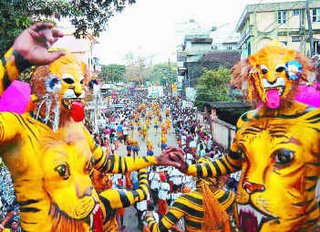Chodhi - Day Three
Third day of the ten-day-long carnival of Onam is called Chothi or Chodi. The day is marked by buzz and lot of activities. Frenzied shopping can be witnessed in the market place all over the state as everybody buys new clothes and accompanying accessories for the grand festival of Onam. Gifts are also procured for everyone in the house including the servants. Some shopping is also done for closed relatives. With the increasing hype for the festival, thanks to the media, shopkeepers too come up with innovative incentives to lure the customers who are in the mood to spend. These days even electronic good keepers offer attractive discounts to cash in on the bullish mood of the festivities.
Well, there are no set rituals for Chothi. Specific flowers are added to Pookalam on this day too. It may be noted that different types of flowers are added to Pookalam on each day as each flower is devoted to a particular deity. As a result Pookalam increases in diameter on this day and gets a refreshing new design.
Well, there are no set rituals for Chothi. Specific flowers are added to Pookalam on this day too. It may be noted that different types of flowers are added to Pookalam on each day as each flower is devoted to a particular deity. As a result Pookalam increases in diameter on this day and gets a refreshing new design.
Pulikali
Pulikali, also known as Kaduvaakali, is a 200 year old art, carefully preserved by the artists of the state. Literal meaning of Pulikali is the 'play of the tigers' hence the performance revolve around the theme of tiger hunting. The folk art is mainly practiced in Thrissur (Trichur) and Palghat districts of Kerala. Best place to watch the show is Swaraj Ground at Thrissur on the fourth day of Onam, where Pulikali troupes from all over the district assemble to display their skills.

The Appearance
Striking feature of this folk art is the colorful appearance of the performers. To get the semblance of a tiger artists paint themselves in bright yellow with patterns of black and red. A tiger mask on the face completes the get up.
It is a painstaking job and artists spend a whole night prior to the performance day on their make-up. Patience of artists must be appreciated, as most paints contain toxic chemicals which create a burning sensation when applied on newly shaved bodies.
The Play
It is a wonderful sight to see humans in the guise of tigers roaming in the streets. Children, specifically take great delight in their performance as the entertainers dance, pounce and walk like a tiger. Scenes of tiger hunting goats and tiger being hunted by a human beings are also beautifully depicted by them. Beat for the dance movement is provided by percussion instruments like 'udukku' and 'thakil'.

No comments:
Post a Comment